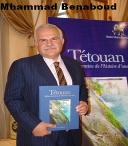The Medina of Tetuan, a World Cultural Heritage City
M’hammad Benaboud,
Despite numerous similarities, the Medina of Tetuan is in many ways geographically, historically, architecturally, culturally and artistically different from other medinas of Morocco. Tetuan’s common features with other Moroccan cities is understandable given the city’s common past and present and its permanent ties with Morocco’s most remote regions. Yet this national unity, does not deny Mororocco’s regional diversity. In this respect Tetuan is an outstanding example reflecting unique specificic elements that are difficult to find elsewhere.
Originality, authenticity and creativity are totally unrelated to size, volume, monetary value or even political, military or economic power. They are the product of social integration and harmony, collective consciousness of belonging to a specific cultural identity and a powerful desire to defend and promote one’s social, urban and archtitectural cultural heritage. For its Roman and Punic ties with the ancient world, its living last five centuries of history, its intellectual contribution to knowledge in such fields as jurisprudence, history, literature, music, cuisine, traditional arts and crafts and its preservation of architectural samples from each of the last five centuries, Tetuan should be classified withing this category. In fact this is basically why it has been declared a World Cultural Heritage city by UNESCO in 1978.
Tetuan’s last five centuries of history are profoundly engraved in its urban structure, architecture and social traditions, customs and style of life. The spirit of the past is still alive in Tetuan, one of Morocco’s most traditional, conservative and dynamic medinas. Its future will inevitably be marked by its past, because its historical monuments reflect such a rich variety of traditional mediterranean style houses decorated with carved and painted wooden doors, a large variety of mosaics decorating floors, pillars, steps and fountains, limestone carved walls, a feature common only in Northern Morocco. Tetuan’s mosques with a great variety of minarets which differ from each other in construction materials and techniquesand in size, colors and decoration.
Tetuan’s underground historical monuments are equally singular. Its Muslim cemetary conserves the memory of those who have contributed to build this enchanring Andalusian medina in Morocco. The Skundu underground water network which feeds public and private fountains in every quarter of the city within its five kilometer city wall has been partially damaged by modernity, but continues to function in many of the city’s private houses and mosques. The Mtamar or Mazmorras, another interesting monument and consist of a natural underground sixteenth century prison and church which was used to host portuguese hostages. The Mazmorras of Tetuan have been mentioned by many Moroccan authors, as well as by renowned literary figures like Cervantes or Leon the African.
There is much to appreciate in the medina of Tetuan. Visiting Tetuan involves walking to the top of the hill from one side, and descending down the same hill from the opposite side. Its quarters are divided into three typs according to their functions: residential areas, commercial areas and industrial areas. Most of the Islamic medina is an Muslim city, except for the Mellah or Jewish Quarter. The White dove is as white from the inside as it appears from a distance thanks to its whitewashed streets, squares, houses and mosques. The city represents the culmination of five centuries of urban and architectural mutations, accompanied by the same period of social, economic, cultural, intelectual and artistic development. The spirit of medina of Tetuan is clear to the visitor in almost every dimension of city’s cultural heritage, because its multi-ethnic society and its multi-cultural heritage cannot be confused with those of any other place.


